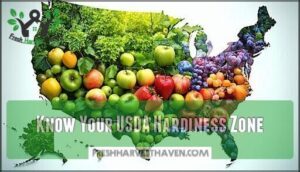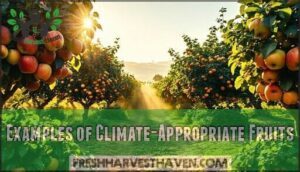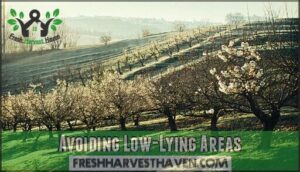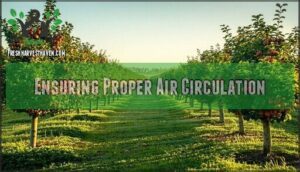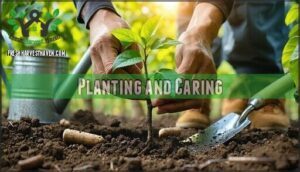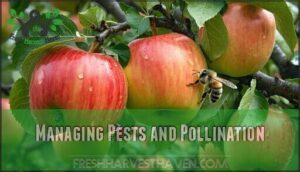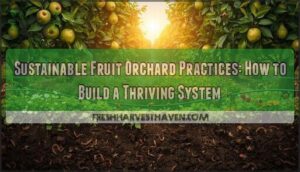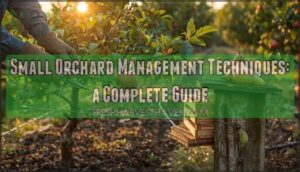This site is supported by our readers. We may earn a commission, at no cost to you, if you purchase through links.
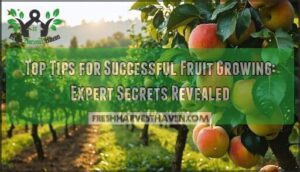
Choose a sunny, well-draining site with good air circulation, avoiding frost pockets.
Test your soil’s pH and amend it with organic matter before planting.
Water deeply but less frequently, and fertilize based on soil test results.
Practice integrated pest management using organic methods when possible.
Consider pollination needs—some fruits self-pollinate while others need cross-pollination partners.
Plant at the right time for your area, typically spring after frost danger passes.
The secret lies in understanding what makes each fruit thrive in your specific environment, which is key to successful fruit growing and requires a good understanding of the local climate zone and local conditions.
Table Of Contents
- Key Takeaways
- Choosing Fruit Varieties
- Site Selection Tips
- Preparing Soil
- Planting and Caring
- Managing Pests and Pollination
- Frequently Asked Questions (FAQs)
- How do I grow fruit successfully?
- What are the best tips for growing fruits?
- Should you grow your own fruits?
- How can I improve the growth of my fruit plants?
- How do I choose a fruit tree?
- How to maximize fruit yields?
- What’s the most profitable fruit to grow?
- How can I improve my fruiting?
- What does baking soda do for fruit trees?
- How can I maximize my fruit production?
- Conclusion
Key Takeaways
- Choose climate-appropriate varieties – You’ll succeed by selecting fruit varieties that match your USDA hardiness zone and local conditions, considering chill hour requirements and disease resistance for your specific area.
- Prepare your soil properly – Test your soil’s pH (aim for 6.0-7.0), improve drainage, and add organic matter like compost before planting to create the foundation your fruit trees need to thrive.
- Select the right location – Plant in sunny spots with at least 6-8 hours of direct sunlight, good air circulation, and well-draining soil, while avoiding low-lying frost pockets.
- Practice integrated pest management – Use organic methods like beneficial insects, neem oil, and proper sanitation, while understanding pollination needs to ensure healthy trees and abundant harvests.
Choosing Fruit Varieties
Your success starts with picking the right fruit varieties for your specific growing conditions and climate zone.
The right variety in the right place makes all the difference between feast and failure.
Understanding your USDA Hardiness Zone and matching it to appropriate fruit types sets the foundation for a thriving orchard.
That’ll reward you with abundant harvests year after year.
Know Your USDA Hardiness Zone
Before growing fruit successfully, you need to know your USDA Hardiness Zones. These zones determine which fruits survive your area’s Extreme Temperatures and First Frost dates.
To achieve success, it’s vital to understand plant hardiness zones and select plants accordingly.
Here’s your action plan:
- Search the official USDA fruit growing zone map online
- Account for Zone Microclimates around your property
- Monitor Zone Changes as climate shifts occur
- Consult Local Nurseries for regional fruit growing tips
- Select varieties matching your specific hardiness zone requirements
Match Fruit Varieties to Local Conditions
Success in fruit growing hinges on microclimate considerations that go beyond your USDA Hardiness Zone.
You’ll need to evaluate chill hour needs—many apples require 800-1,200 hours below 45°F, while peaches need just 150-1,000 hours.
Consider rootstock selection carefully; dwarf rootstocks thrive in containers but struggle in windy locations.
Regional fruit trials reveal which fruit varieties perform best locally.
Disease resistance becomes vital—choose varieties that handle your area’s common problems naturally.
Your climate-appropriate fruits should match rainfall patterns, humidity levels, and temperature swings.
This targeted approach guarantees your orchard thrives with minimal intervention.
Examples of Climate-Appropriate Fruits
Different climates call for different fruit varieties to guarantee your garden thrives.
In cold zones, apples, pears, and raspberries handle harsh winters beautifully. Zone-specific fruits like citrus love subtropical warmth, while hardy gooseberries survive zone 2 conditions.
Chill hour needs matter—peaches require winter cold snaps for spring blooms. Consider humidity tolerances and rainfall impact when selecting varieties.
Drought-tolerant figs excel in arid regions, while blueberries prefer consistent moisture. Understanding microclimate effects helps you choose climate-appropriate fruits that’ll flourish naturally in your specific growing conditions.
To guarantee success, prioritize site selection with full sun and good drainage.
Site Selection Tips
You’ll want to pick the right spot for your fruit trees since location affects everything from harvest size to disease resistance.
The perfect site combines full sun, good drainage, wind protection, and enough space for your trees to thrive without competing for resources.
Selecting The Ideal Location
Finding the perfect spot for your fruit trees sets the foundation for years of successful harvests. Sunlight Exposure remains your top priority—aim for locations receiving six to eight hours of direct sun daily.
Here’s your site selection checklist:
- Evaluate Sunlight Exposure throughout the day for ideal photosynthesis
- Test Soil Drainage by digging a hole and checking water absorption
- Ensure Water Access within 50 feet for convenient irrigation
- Install Wind Protection using fences or hedges against harsh weather
- Consider Microclimates around buildings that affect temperature and moisture
Proper fruit tree spacing prevents overcrowding while maximizing light penetration and air circulation.
Avoiding Low-Lying Areas
Low-lying areas create frost pockets where cold air settles, threatening your fruit trees’ delicate blooms.
These spots also face waterlogging risks that suffocate roots and compromise soil drainage. Choose elevated locations for better air drainage and root health.
Even slight slope benefits improve fruit tree soil drainage substantially. One key factor is understanding summer garden watering for ideal growth.
| Problem | Solution |
|---|---|
| Frost Pockets form in valleys | Plant on slopes for better air drainage |
| Waterlogging Risks damage roots | Select elevated sites with natural fruit tree soil drainage |
| Poor root health from wet conditions | Guarantee proper soil preparation and watering strategies |
Ensuring Proper Air Circulation
Good airflow prevents fungal diseases that thrive in stagnant, humid conditions.
Follow proper spacing guidelines when planting—dwarf varieties need twelve to fourteen feet between trees for ideal sunlight penetration.
Strategic windbreaks provide protection without blocking essential air movement.
Regular pruning techniques open dense canopies, allowing air to circulate freely through branches.
This natural ventilation reduces moisture buildup that leads to fruit tree diseases.
Smart fruit tree training creates open centers that promote airflow while maintaining structural integrity for disease prevention.
Preparing Soil
Your fruit trees deserve more than just good intentions—they need properly prepared soil to thrive.
Before you plant, you’ll want to evaluate your soil quality, conduct essential tests, and make the right amendments to create the perfect growing foundation.
Evaluating Soil Quality
Your soil’s composition tells you everything about your future harvest.
Test for crumbly texture and organic matter content first. Check drainage by digging a hole—water shouldn’t pool.
Most fruit tree soil needs pH between 6.0-7.0, while nutrient levels determine fertilizer needs.
Poor soil fertility means struggling trees, so evaluate these factors before planting anything.
Conducting Soil Tests
Before planting, soil testing reveals essential insights about your fruit tree soil.
Test pH levels, nutrient deficiencies, and soil composition using DIY kits or professional labs. Drainage assessment identifies waterlogging risks that harm roots.
Annual testing tracks soil fertility changes over time. Results pinpoint specific amendment needs, eliminating guesswork and ensuring your trees get proper nutrition for healthy growth and abundant harvests.
Consider amending sandy soils to improve water retention capabilities.
Amending Soil
After soil testing reveals what your earth needs, it’s time to transform it into fruit-growing gold. Strategic organic amendments work wonders for soil fertility and structure.
Here’s your soil-boosting action plan:
- Mix compost or aged manure to boost organic matter
- Add lime for acidic soils, sulfur for alkaline (targeting ideal soil pH)
- Incorporate sand or create raised beds for better soil drainage
- Apply surface amendments rather than deep mixing for lasting results
To understand your soil composition, consider using a reliable soil analysis. Smart amendments create the foundation your fruit trees crave.
Planting and Caring
Once you’ve prepared your soil properly, it’s time to put your fruit trees or plants in the ground and establish a care routine that’ll set them up for years of productive growth.
The planting process and early care decisions you make now will directly impact your harvest success, so getting these fundamentals right from the start is vital.
Selecting a Location
Success starts with choosing the perfect spot for your fruit trees.
You’ll need sunlight exposure of at least six hours daily for maximum growth.
Avoid low-lying areas that create frost pockets and compromise your harvest.
| Location Factor | Poor Choice | Excellent Choice |
|---|---|---|
| Sunlight | Shaded areas | Full sun exposure |
| Drainage | Waterlogged soil | Well-draining ground |
| Wind | Exposed hilltops | Protected valleys |
Focus on soil drainage to prevent root rot, and guarantee water access for consistent irrigation.
Wind protection through natural barriers or hedges shields your trees from harsh weather.
Consider microclimates within your yard—these small climate variations can substantially impact fruit tree climate zones and overall success.
Best Time to Plant
Timing your fruit tree planting can make or break your garden’s success.
Climate considerations and regional variations determine when you’ll plant. In colder zones, late winter to early spring works best, after the dormancy period ends but before buds break.
Warmer regions can plant in fall, allowing root establishment before summer heat. Check your local frost dates – plant two weeks after the last expected frost.
This fruit tree planting time guarantees trees establish properly before facing weather extremes.
Planting Techniques
How do you guarantee your fruit trees get the best start? Dig holes twice the root ball size width but equal depth.
Keep the graft union placement slightly above soil level—this prevents rot and ensures proper growth. Follow spacing guidelines: apples need 15-20 feet apart, peaches 12-18 feet.
Proper fruit tree planting techniques prevent competition for nutrients and maximize sunlight exposure for each tree. For ideal growth, guarantee your location has at least six hours of direct sunlight.
Watering Practices
Deep watering transforms fruit tree care from guesswork into science.
Water young trees 1–2 times weekly using drip irrigation for consistent moisture penetration.
Mature trees need watering every 7–10 days.
Check soil 2–4 inches down—if dry, it’s time.
Mulch benefits include moisture retention, while overwatering risks include root rot.
Proper watering frequency prevents drought stress effectively.
Fertilization Techniques
Three key fertilizer types can transform your fruit trees’ health. Organic amendments like compost provide slow-release nutrients and improve soil pH naturally.
Balanced fertilizers with equal nitrogen-phosphorus-potassium ratios support overall growth. Spring fertilization maximizes fruit tree nutrient uptake when trees actively grow.
Watch for nutrient deficiencies – yellowing leaves often signal nitrogen needs. Apply fruit tree fertilizer around the drip line, not against the trunk.
Smart nutrient management means testing soil first, then choosing appropriate fertilizer types for long-term success. Proper application requires specialized tree fertilizer.
Managing Pests and Pollination
You’ll face various challenges from tiny aphids to fungal diseases that can quickly damage your fruit harvest if left unchecked.
Understanding pollination requirements is equally important since many fruit trees depend on cross-pollination or specific pollinators to produce abundant crops.
Common Pests
After planting your fruit trees properly, you’ll face common fruit pests that threaten your harvest.
Aphid control starts with spotting curled leaves and sticky honeydew on branches. Codling moths create telltale holes in apples and pears, while fruit flies make cherries unmarketable.
Watch for scale insects on bark and implement mite management when leaves show stippling.
Integrated Pest Management (IPM) combines monitoring with targeted treatments for effective pest management of fruit tree pests.
Disease Prevention
Smart gardeners know that disease prevention beats treatment every time. Resistant varieties form your first line of defense, while proper spacing maintains vital airflow importance around plants.
Follow these essential disease prevention steps:
- Practice strict sanitation practices by removing fallen fruit and infected plant material immediately
- Apply preventative sprays using copper or sulfur-based fungicides during vulnerable periods
- Master early detection through weekly garden inspections for suspicious spots or wilting
Integrated Pest Management IPM combines these strategies with organic solutions for thorough disease management that keeps fruit diseases at bay naturally.
Organic Pest Control
Nature’s arsenal offers powerful organic pest control solutions for your fruit trees.
Neem Oil disrupts pest lifecycles, while Insecticidal Soap tackles soft-bodied insects like aphids. Pheromone Traps capture moths before they damage fruit. Copper Fungicide prevents fungal diseases effectively.
Beneficial insects like ladybugs and lacewings provide Biological Control by consuming hundreds of pests daily. You can find effective neem oil products for your garden.
This Integrated Pest Management IPM approach combines multiple organic solutions for thorough pest management without harmful chemicals.
Self-Pollinating Trees
Self-pollinating fruit trees offer independence from cross-pollination requirements, making fruit growing accessible for smaller gardens.
These varieties contain both male and female reproductive parts, enabling successful fruit set without external pollen sources.
Pollination mechanisms in self-pollinating cultivars rely on genetic factors that allow fertilization within individual flowers.
Key advantages include:
- Reliable yields: Fruit trees produce consistent harvests regardless of nearby pollinator populations
- Space efficiency: Single tree plantings work well for compact gardens or container growing
- Simplified cultivar selection: No need to research compatible varieties for cross-pollination
Peaches, nectarines, and most citrus varieties excel as self-pollinating options.
However, yield expectations may vary based on environmental conditions and tree health.
Even pollinator-friendly gardens benefit from these independent producers, ensuring fruit tree pollination success when weather limits bee activity.
Cross-Pollination
Some fruit trees can’t go it alone. Apples, pears, and plums need Pollination Partners with matching Bloom Timing for successful crosspollination.
Pollen Compatibility between varieties guarantees proper Fruit Set. Choose genetically diverse partners that flower simultaneously.
This fruit tree pollination strategy creates Genetic Diversity and maximizes harvests through effective pollinatorfriendly partnerships supporting robust fruit tree pollinator support.
Attracting Pollinators
Welcoming pollinators transforms your garden into a fruit-producing powerhouse.
Create the perfect pollinator habitat by establishing these essential elements:
- Plant native plants that bloom throughout seasons for consistent nectar sources
- Provide water sources like shallow dishes or small ponds for thirsty visitors
- Maintain year-round blooms to support pollinators beyond fruit tree flowering periods
- Reduce pesticides during bloom times to protect beneficial insects
These pollinator-friendly practices boost fruit tree pollination requirements while supporting healthy ecosystems that benefit your harvest long-term.
Frequently Asked Questions (FAQs)
How do I grow fruit successfully?
Good soil bears good fruit – choose sunny spots with well-draining soil.
Water deeply but infrequently, mulch around plants.
Test soil pH regularly, and select varieties suited to your climate zone for ideal harvests.
What are the best tips for growing fruits?
Choose your site wisely—select sunny, well-drained spots with wind protection.
Test and amend soil pH to 0-
Water deeply but infrequently, mulch generously, and practice integrated pest management for healthy harvests.
Should you grow your own fruits?
Despite concerns about space or time, you’ll enjoy fresh, chemical-free produce while saving money long-term. Growing fruits teaches patience, connects you with nature, and provides rewarding harvests year-round.
How can I improve the growth of my fruit plants?
Test your soil’s pH and nutrients first.
Add compost to improve structure and fertility.
Water deeply but less frequently to encourage strong root systems.
Mulch around plants to retain moisture and suppress weeds, this includes using it to retain moisture.
How do I choose a fruit tree?
Consider your climate zone first—cold areas need hardy varieties like apples, while warm zones support citrus.
Match your space to tree size, check pollination needs, and prioritize disease-resistant cultivars for easier maintenance.
How to maximize fruit yields?
Maximize yields by ensuring proper spacing for airflow, deep weekly watering, spring fertilization, regular pruning for sunlight penetration, and consistent pest management throughout the growing season.
What’s the most profitable fruit to grow?
You’ll want to focus on avocados for long-term profits or berries like blueberries for quick returns. Both command premium prices, have growing demand, and suit different scales perfectly.
How can I improve my fruiting?
You’re basically playing fruit tree roulette if you ignore soil pH, drainage, and spacing.
Test soil, water deeply but infrequently, mulch heavily, choose disease-resistant varieties, and make certain of proper pollination partnerships.
What does baking soda do for fruit trees?
Baking soda works as a natural fungicide for fruit trees, helping prevent diseases like powdery mildew and black spot.
You’ll mix it with water and spray it on leaves to create an alkaline environment that inhibits fungal growth effectively.
How can I maximize my fruit production?
Transform your backyard into a fruit paradise!
Select disease-resistant varieties, provide consistent deep watering, maintain proper soil pH (0-0).
Make certain cross-pollination partners, apply balanced fertilizer in spring, and use organic mulch for maximum yields.
Conclusion
Like the ancient gardener who understood nature’s rhythms, you’ll find success when you apply these top tips for successful fruit growing consistently.
Start by choosing climate-appropriate varieties and preparing your soil properly.
Select sunny, well-draining sites with good air circulation.
Water deeply but infrequently, and practice integrated pest management using organic methods.
Remember pollination requirements and plant at the ideal time for your region.
With patience and these proven techniques, you’ll harvest abundant, delicious fruit for years to come.
- https://mahoneysgarden.com/a-beginners-guide-fruit-tree-care/
- https://myperfectplants.com/products/fruit-tree-planting-mix
- https://artisticgardener.wordpress.com/2015/04/15/fruit-trees-how-to-prepare-soil-for-planting/
- https://growingfruit.org/t/my-soil-analysis-vs-planting-fruit-trees/69120
- https://extension.umd.edu/resource/fruit-plant-care

